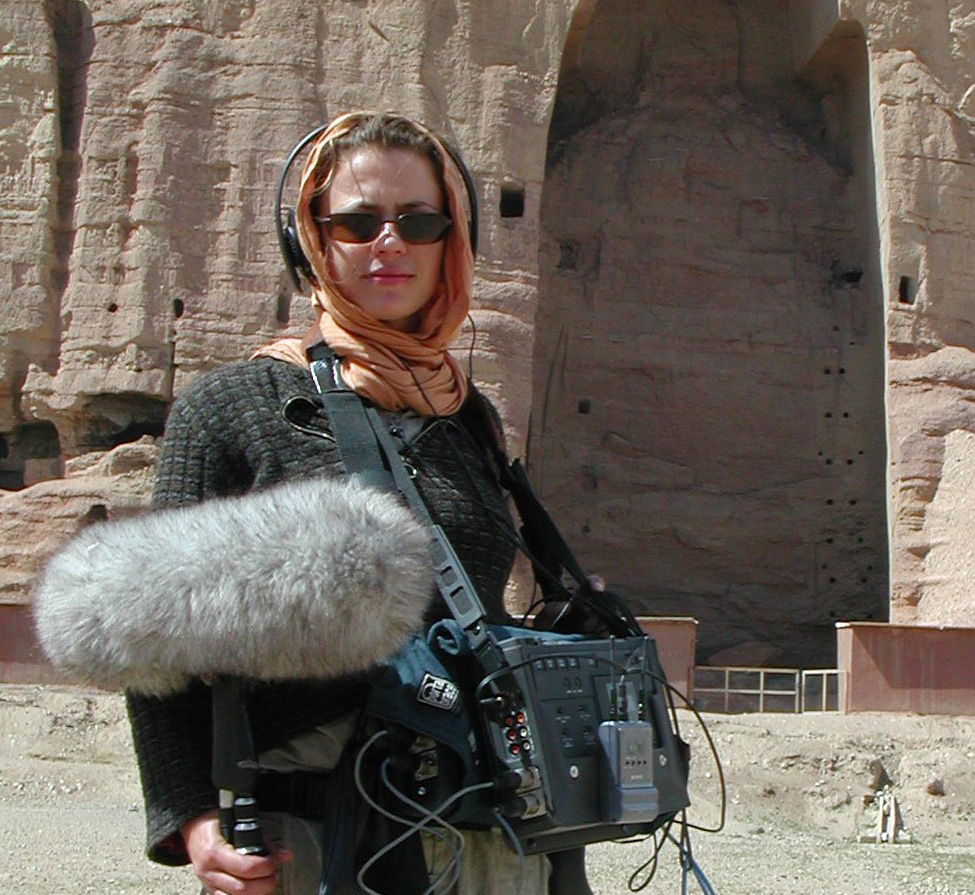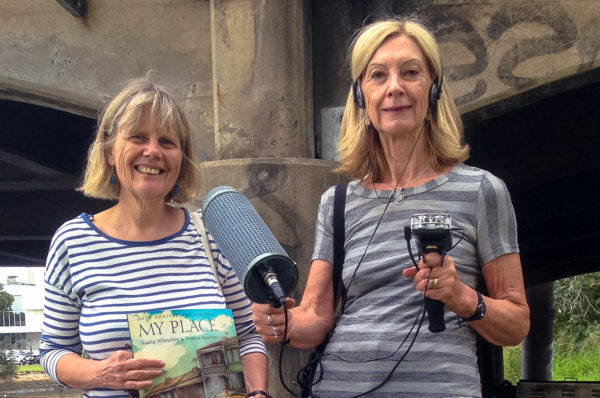Radio maker and academic Kyla Brettle explores the backstory to creative audio in Australia – and finds today’s blossoming podcast scene at the crest of a wave that’s been building for decades.

As a radio maker, most of the time I describe what I make by what it isn’t – ‘it’s like a documentary film without images’ or, for those more familiar with literature, ‘it’s like creative non-fiction without type’. So when I talk about ‘radio’, I’m not referring to shock jocks and playlists, talkback and chat, or even drive or breakfast – I’m speaking about a creative and sound-rich corner of the greater field of audio content referred to as ‘documentaries and features’.
This genre was actually declared ‘almost extinct’ as recently as 2009 in Hugh Chignells’ authoritative Key Concepts in Radio Studies. The genre wasn’t dead, however – it was just rendered invisible. Prominent Australian radio documentary historian Virginia Madsen described it in 2005 as ‘utterly repressed’ and ‘all but unknown critically and academically’. But this state is changing as we move through what many are heralding as the new ‘golden age’ of radio.
The ‘ghastly impermanence’ of radio
In the west, the creative potential of radio as a ‘theatre of the mind’ was principally developed by trained professionals with access to expensive equipment through plum jobs in drama and feature departments within public service broadcasters – nice work if you can get it.
The first features and documentaries were commonly scripted and performed by actors.
The first features and documentaries were commonly scripted and performed by actors. While the form had been around since the 1920s, the Prix Italia (an influential international radio competition), didn’t introduce a ‘radio feature’ section until 1953. An early use of ‘wild sound’ or ‘actuality’ can be heard in Radio Ballads by Charles Parker, Ewan MacColl and Peggy Seeger (1958-1964); a mix of music and storytelling which brought the richly textured voices of ‘real people’ to the air. Advancements in portable stereo audio recording enabled makers to escape the stuffy confines of the studio and engage with the visceral sounds of the world. The ‘first real breakthrough in acoustic film’, as Peter Leonard Braun, founder of the International Features Conference, puts it, was heralded by Polish documentarian Witold Zadrowski’s Death of an Elephant (1965); a 42-minute ‘montage of life recordings’ depicting an elephant hunt in the wilds of Africa – told through whispers, rustling and gunshots.
Hear about how ‘The Radio Ballads’ were made in ‘Scene to Song: The Radio Ballads’, produced by Ros Bluett for ABC Radio National’s Hindsight:
This was an age marked by what the writer and BBC producer Lance Sieveking called the ‘ghastly impermanence’ of radio. Features were tethered to the terrestrial and temporal limitations of broadcast, and stamped with the ‘house sound’ of the large organisations that monopolised production.
It’s not simply the broadcasters’ accents that makes the ‘BBC sound’ different from that of NPR. We hear it subliminally through the preferred curve of an audio fade, transitions used, approaches to sound layering and the severity of voice editing. Easier to identify are differences in the kinds of stories and ideas radio features explore, and in the way sound and voice is used to ‘write’ for radio.
More broadly, regional styles and approaches emerged. For example, in Europe features tended to be poetic and layered – closely aligned to audio arts. British documentaries were shadowed by the BBC’s founding Reithian aim to inform and educate, while in America, radio documentaries were more closely related to journalism.
Antipodean audio
The influence of the European radiophonic approach filtered through to Australia in the early 1970s, nurtured by Richard Connolly, then the head of ABC Radio Drama and Features. A young research assistant, Kaye Mortley, was charged with the task of reviewing the reams of European features Connolly had brought back on tape. Inspired and energised by what she heard, Mortley went on to become a lauded audio documentarian herself; her acoustically complex and poetic ‘radio films’ have made a ‘significant contribution to the field of radio creation internationally’.
The form wasn’t popular enough for commercial networks, and community radio lacked the resources.
In Australia, as elsewhere, the national broadcaster was virtually the only organisation to consistently produce radio features and documentaries – the form wasn’t popular enough for commercial networks, and community radio lacked the resources (I’m wading into some brackish water here – but am distinguishing between experimental music and radio features). In particular, two ABC Radio National feature and acoustic arts programmes served as important crucibles for the development of an Australian sound.

Surface Tension, launched in 1985 and aired at the prime time of Saturday afternoons, was ‘madly adventurous’ and alternative, recalls producer Robyn Ravlich. Ravlich’s own body of work and 35 year career at ABC RN is a keystone of the Australian sound of this period; she describes her approach as ‘engaging the ear’ and taking ‘people on a journey through experience into ideas’. Gail Priest, another producer at the time, describes Surface Tension as ‘open[ing] up Australian ears to local experiment, the new genre of soundscape, cutting-edge stereophonic radio documentary and hybrid performance works then being produced in Europe’.
Surface Tension only ran for two years before it was folded into a new programme (with a less conspicuous time-slot) called The Listening Room (1988–2003).
An award winning acoustic arts program, The Listening Room was broadcast on both RN’s AM band and in stereo on ABC Classic FM – and is often cited as having a significant impact on the radio feature and documentary culture in Australia. The programme brought together producers, sound engineers and guest artists (from musicians to writers and performance artists) to explore ‘radio forms and imaginative programme making’. Tony Barrell, another acclaimed producer of the time, described his notion of a radio feature in an interview with Eurydice Aroney as a hybrid – ‘a piece of artistic freewheeling self expression-based acoustic arts pieces AND the kind of information or analysis feature one might expect from a public broadcaster’.
Many other unique ‘voices’ and approaches were fostered through The Listening Room, from the musical soundscapes of Sherre DeLys to the droll first person narration of Natalie Kestecher. Other key makers heard through The Listening Room include (but are certainly not limited to!) Jane Ulman, Sharon Davis, Lea Redfern, Gretchen Miller, Russell Stapleton and John Jacobs.
The influence of radiophonic sensibilities and an experimental approach to programme making sent ripples across RN.
The influence of radiophonic sensibilities and an experimental approach to programme making sent ripples across RN. For example, history programmes like Hindsight (1999–2015), the documentary programme Radio Eye (1998–2009), and the music feature programme Into the Music (2006–2015) took on a more creative approach. After the turn of the century, the pointy end of experimentation in audio features was picked up by the remix programme The Night Air (2002–2013) and Radio National’s media sharing site, ABC Pool (2008–2013), where radio producers solicited ‘user generated content’ to explore ‘co-creative’ or ‘participatory’ production approaches. Today, RN features and documentaries can be heard on the Creative Audio Unit programmes Soundproof and This is About (recently reborn from its earlier incarnation as Radiotonic), as well as on the weekday afternoon programme, Earshot.
Sound on screens
In the frenetic media ecology of today’s internet, audio features and documentaries have materialised and edged towards the centre of a crowded screen. More people are listening to and making radio documentaries and features than ever before. High profile American programmes like Serial, This American Life and RadioLab are generating massive podcast audiences. In Australia, commissioning editors of feature programmes on Radio National are receiving more proposals for new work than ever. Community radio has sprouted initiatives to encourage feature making, including shows like All The Best, and the Community Broadcasting Association of Australia’s National Features and Documentary Series and CRN Segments Series.
And all over the world, podcasters are making, publishing and being heard outside the broadcast system. There are more places to listen and to source work – from online-only audio magazines and portals like ARTE in France and US-based organisations like The [Un]observed and Radiotopia and audio production-house websites like The Kitchen Sisters, Radio Diaries, Falling Tree Productions and Paper Radio.
For Australians, it’s easy to find information about how to make and sell features and documentaries – from websites like Transom.org, AIR.org and the Public Radio Exchange (PRX), as well as through more grass roots groups and blogs which focus on this kind of work, such as the Australian Radio Collective Facebook group and EarRelevant. Universities like RMIT, University of Wollongong, LaTrobe and Macquarie offer classes in creative radio making, while other organisations like the Community Media Training Organisation (CMTO) espouse similar values in different environments.
Raising the profile of radio features are live events like In the Dark (a local chapter of a UK-based events program) and a proliferation of competitions and festivals celebrating the form (and in many cases, awarding Australian radio makers), from the newly-hatched homegrown Audiocraft to Ireland’s HearSay International Audio Arts Festival, and the ‘Sundance of radio’ – Chicago’s Third Coast International Audio Festival.
Radio without borders
It’s like a swollen river of sound out there – a turgid mix of styles and approaches colliding. From poetic to observational, abstract or more essayistic, investigative to first person storytelling, this practice of describing radio documentaries and features by what they aren’t seems inadequate.
This practice of describing radio documentaries and features by what they aren’t seems inadequate.
In the 2010 anthology Reality Radio, editors John Biewen and Alexa Dilworth made inroads on a positive definition of the genre. This collection of essays enlists prominent practitioners from around the globe, each describing their unique approach to ‘telling true stories in sound’. Biewen, in his introduction, describes radio documentary makers as people who ‘use sound to tell true stories artfully’. The ‘truth’ here is framed as the authored and necessarily subjective viewpoint of the producers: to tell these stories artfully means ‘to gather words and sounds and music, and assemble them, painstakingly, into an experience’.
Hear a radio documentary about radio documentaries – Alan Hall’s ‘The Ballad of the Radio Feature’ (2008), produced by Falling Tree Productions:
A more sustained and academic enquiry into the genre is presented in the new Australian journal RadioDoc Review, which commissions in-depth reviews and essays about radio documentaries and features – and is playing a key role in the development of a language to elucidate the complexities of the form.
Are we sounding like (the) US?
Much work remains ahead in charting and making sense of what is happening to audio documentaries and features in this period of rapid change, and evaluating innovations and limitations. In recent years, for example, the cultural influence of the US approaches to the form has been notably strong amongst Australian makers.
Much work remains ahead in charting and making sense of what is happening to audio documentaries and features.
In their essay ‘Not dead yet: emerging trends in radio documentary forms in Australia and US’, Mia Lindgren and Siobhan McHugh point out that Australian features and documentaries are ‘moving away from artful, abstract writing through sound, made popular by European producers from the ‘60s, towards a more first-person, explicitly narrated format favoured by American producers’.
Perhaps this is in part due to the level of leadership the US has shown in developing online hubs and support for emerging makers, and the adaptability of its established ‘indie’ radio producer culture to the global marketplace online.
However the wind blows, audio features and documentaries have now become clearly ‘visible’ with shiny digital durability – and they’re making an impression with new audiences both popular and critical. As the dust settles, how will Australian stories sound next?
(Lead image: Kyla Brettle recording in Bamiyan, Afghanistan.)